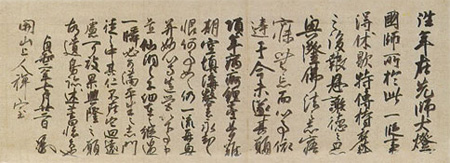【The Founding Principles of Myōshin-ji】
 Emperor Hanazon’s Letter to Zen Master Kanzan
Emperor Hanazon’s Letter to Zen Master Kanzan
Myōshin-ji was founded in 1337 when the cloistered emperor Hanazono (1297-1348), a devoted practicer of Zen meditation, converted his imperial villa to a temple. In 1347, Hanazono, then in bed with his final illness, wrote a letter urging Zen master Kanzan Egen 関山慧玄 (1277-1360), the temple’s first abbot, to continue his work in developing Myōshin-ji as a place for true Zen training. Through the efforts of Kanzan and his successors, Myōshin-ji has grown over the centuries and is presently the head temple of the largest branch of Rinzai Zen Buddhism.
As a temple in the Buddhist tradition, Myōshin-ji is concerned with the same central questions that occupied Gautama Shakyamuni, the historical Buddha: What is the nature of human suffering, and how can this suffering be resolved? The Buddha saw the root of suffering as lying in a basic misunderstanding of the true nature of reality. We tend to seek happiness and stability in certain things remaining unchanged, yet the Buddha saw that all things are in a state of constant flux (anitya); as individuals we tend to identify our inner essence with an eternal self, yet the Buddha saw that no conditioned existence possesses an unchanging self and that our true state is one of no-self (anātman). The Buddha further taught that through a deep experiential realization of the nature of anitya and anātman we can resolve the problem of suffering and attain enlightenment, which is, in essence, toawaken to the Buddha Mind that is inherent in all beings, though ordinarily hidden by deluded thought. The primary practice advocated by the Buddha for attaining this awakening was that of dhyāna (meditation). Zen maintains this original emphasis on dhyāna, known in the Zen school as zazen.
Since the time of its founding Myōshin-ji has retained this fundamental dedication to enlightenment through the practice of zazen. In his letter of 1347 to Kanzan reiterating his hopes for Myōshin-ji, the cloistered emperor Hanazono expressed the gratitude he felt for the Zen teachings that had enabled him to find peace of mind and his desire to repay his debt to the Buddha for revealing the Way to alleviate human suffering. In Zen, repayment of this debt of is accomplished by attaining enlightenment for ourselves and helping others to do the same. Emperor Hanazono saw an effective means of furthering these goals in Kanzan’s Zen teaching, summarized in Kanzan’s maxim, “Kou, sono moto o tsutomeyō” (I beseech you, examine the Source!)—that is, awaken to your innate Buddha-nature through deep contemplation of the source of the mind.
Emperor Hanazono passed away in the autumn of 1348, but his dream was realized when Kanzan dedicated the remainder of his life to teaching disciples and enlarging Myōshin-ji. The efforts of Emperor Hanazono and Zen master Kanzan have continued to bear fruit to the present day. Myōshin-ji promotes harmonious relations between its clergy and the laity and endeavors to spread the spirit and practices of Zen. Toward this end it maintains Zen centers and monasteries in Japan and elsewhere to train priests and offer laypeople the opportunity to practice Zen meditation. It also operates educational facilities such as Hanazono Middle School, Hanazono High School, and Hanazono University, and sponsors lectures and study groups throughout the country.
The standpoint of Myōshin-ji and the Rinzai Zen school is that the Zen mind should play an active part in everyday life. The true life of the spirit is based on a mind that is tranquil and joyful, and on a feeling of gratitude for all that we receive from others and from the world around us. To foster this outlook Myōshin-ji has formulated “Guidelines for Everyday Spirituality” and “Teachings for Spiritual Practice”:
Guidelines for Everyday Spirituality (Seikatsu Shinjyo)
Once in each and every day let us meditate in stillness, and bring into harmony our bodies, our breathing, and our minds.
Let us awaken to the nobility of human existence, and cherish our lives and the lives of others.
Let us appreciate the gift of being, and live our days in a spirit of gratitude.
Teachings for Spiritual Practice (Shinjin no Kotoba)
Let us meditate quietly, contemplating the emptiness of our physical form.
Let us practice devotedly, knowing that ordinary beings are essentially buddhas.
Let us live harmoniously, regarding society as the garden of our spirit.
Emperor Hanazono’s Letter (Goshinkan) to Kanzan Egen
Under the guidance of my teacher Daitō Kokushi I was able to obtain a quiet certainty regarding the great matter of birth and death. Ever since my teacher transmitted to me the very essence of the Buddha Way it has been my wish to repay my debt of gratitude to him, to express my appreciation for his great virtue, and also to do what I can to promote the prosperity of Buddhism. However, there has been a gap between what I intended to do in spirit and what I was able to accomplish in practice, so these wishes remain unfulfilled. Now I am afflicted with a strange illness and do not know how much longer I have to live. If I pass away without carrying out my intentions I will have died in vain. Thus I will write to Kōgon in the Imperial Palace regarding the renewal of our Zen school and the planned construction of buildings for Myoshin-ji. Though the time remaining to me is short, I must do what I can to see that my heart’s desires are realized. In our Zen school, you are the very man capable of accomplishing this. It is my earnest request that you embrace this clear vision for the future and accede to my wish for the prosperity of our denomination. I have therefore been so bold as to write this letter to express my strong determination.

